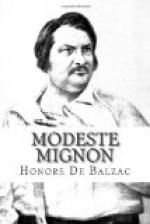Dumay sent agents to represent his master in New York, Paris, and London, and followed up the assignments of the three banking-houses whose failure had caused the ruin of the Havre house, thus realizing five hundred thousand francs between 1826 and 1828, an eighth of Charles’s whole fortune; then, according to the latter’s directions given on the night of his departure, he sent that sum to New York through the house of Mongenod to the credit of Monsieur Charles Mignon. All this was done with military obedience, except in a matter of withholding thirty thousand francs for the personal expenses of Madame and Mademoiselle Mignon as the colonel had ordered him to do, but which Dumay did not do. The Breton sold his own little house for twenty thousand francs, which sum he gave to Madame Mignon, believing that the more capital he sent to his colonel the sooner the latter would return.
“He might perish for the want of thirty thousand francs,” Dumay remarked to Latournelle, who bought the little house at its full value, where an apartment was always kept ready for the inhabitants of the Chalet.
CHAPTER IV
A simple story
Such was the result to the celebrated house of Mignon at Havre of the crisis of 1825-26, which convulsed many of the principal business centres in Europe and caused the ruin of several Parisian bankers, among them (as those who remember that crisis will recall) the president of the chamber of commerce.
We can now understand how this great disaster, coming suddenly at the close of ten years of domestic happiness, might well have been the death of Bettina Mignon, again separated from her husband and ignorant of his fate,—to her as adventurous and perilous as the exile to Siberia. But the grief which was dragging her to the grave was far other than these visible sorrows. The caustic that was slowly eating into her heart lay beneath a stone in the little graveyard of Ingouville, on which was inscribed:—
BettinaCaroline mignon
Died aged twenty-two.
Pray for her.
This inscription is to the young girl whom it covered what many another epitaph has been for the dead lying beneath them,—a table of contents to a hidden book. Here is the book, in its dreadful brevity; and it will explain the oath exacted and taken when the colonel and the lieutenant bade each other farewell.
A young man of charming appearance, named Charles d’Estourny, came to Havre for the commonplace purpose of being near the sea, and there he saw Bettina Mignon. A “soi-disant” fashionable Parisian is never without introductions, and he was invited at the instance of a friend of the Mignons to a fete given at Ingouville. He fell in love with Bettina and with her fortune, and in three months he had done the work of seduction and enticed her away. The father of a family of daughters should no more allow a young man whom he does not know to enter his home than he should leave books and papers lying about which he has not read. A young girl’s innocence is like milk, which a small matter turns sour,—a clap of thunder, an evil odor, a hot day, a mere breath.




